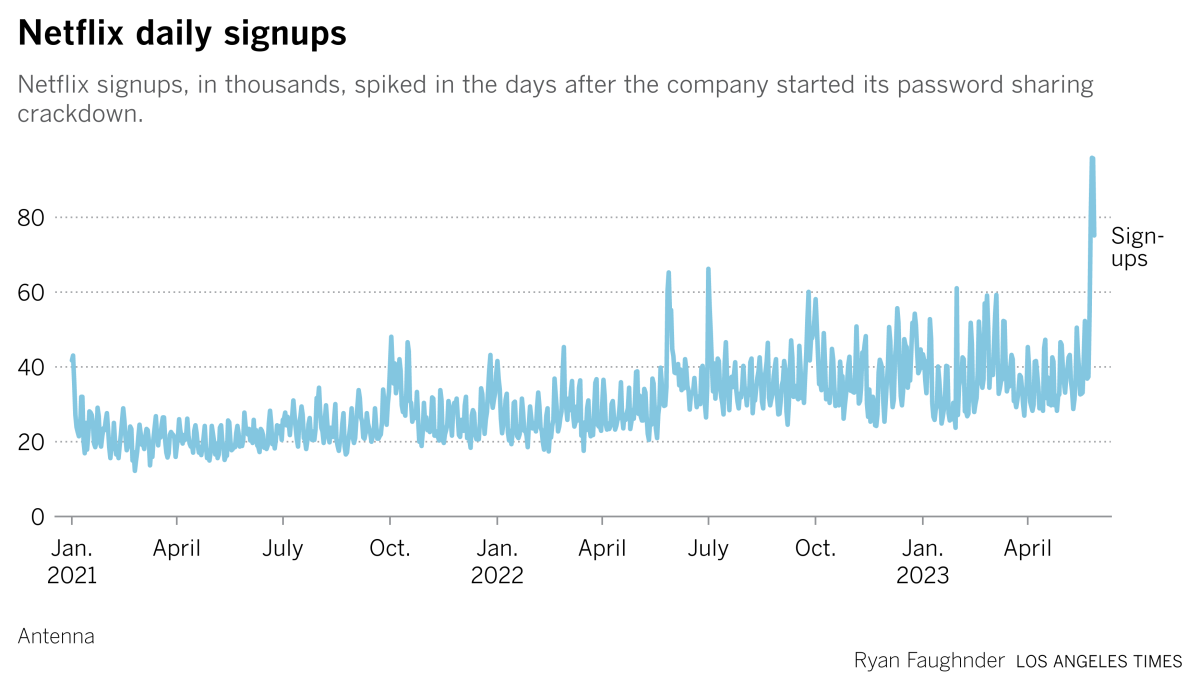‘Spider-Man: Across the Spider-Verse’ and the new shape of Hollywood animation

- Share via
Welcome to the Wide Shot, a newsletter about the business of entertainment. Sign up here to get it in your inbox.
To paraphrase and expand upon Guillermo Del Toro’s oft-repeated call to arms during the Oscar campaign for his stop-motion “Pinocchio,” animation is not a genre.
It’s a medium.
And, of course, a huge business.
One that is changing rapidly, with a competitive landscape that has evolved in the years after the COVID-19 pandemic shuttered cinemas.
The enthusiastic audience response to recent animated releases has shown the popularity of the format operating in a variety of films, despite unfounded worries that families would avoid movie theaters following the public health crisis.
Sony Pictures’ “Spider-Man: Across the Spider-Verse” has grossed $390 million globally in its first 12 days, performing as much like a superhero movie as a PG-rated family title, already topping the run of its predecessor. The “Spider-Verse” sequel’s win comes after Universal Pictures and Illumination Entertainment’s “The Super Mario Bros. Movie” surpassed $1.3-billion in box office sales, becoming the highest-grossing movie of the year so far.
I mention these two mostly unrelated films in the same breath to note the lack of hegemony in today’s animation business, particularly as Disney and Pixar — long the dominant players among family crowds — struggle to recover from the COVID-19-era decision to release multiple films directly to Disney+. Pixar’s latest effort, “Elemental,” is tracking to open with a modest $35 million to $40 million in the U.S. and Canada this weekend.
It’s no accident that the look of big commercial animated films is changing as well, with new, popular styles and techniques that often deviate from the smooth, 3-D computer-generated sheen that has defined much of animation practically since the first “Toy Story.”
In 2018, “Spider-Man: Into the Spider-Verse,” Sony’s first movie to feature Miles Morales as the Marvel webslinger, introduced audiences to a visual approach that combined computerized animation with 2-D elements. This cocktail evoked the imagery and movement of classic comic book pages while also giving the movie a unique feel, along with its multiversal glitches.
When I wrote about the film’s Oscar nomination for animated feature (it later won the award, over movies including “Incredibles 2”), co-director Peter Ramsey said the film’s success could encourage studios and filmmakers to take risks on different kinds of animated films and that it could “push the door open a little bit.” Audiences were hungry for something new, went the hypothesis.
Indeed, the “Spider-Verse” clearly did inspire a bit of a trend.
With Universal’s hit “Puss in Boots: The Last Wish,” DreamWorks Animation incorporated techniques to make the finished product look more hand-drawn than previous “Shrek”-adjacent movies. While this was done in the service of the film’s storybook themes, it also called to mind the frenetic action of anime and video games, especially during its opening sequence with the feline hero battling a giant monster.
A similar hybrid style is set to return to the big screen in August with Paramount Pictures’ ”Teenage Mutant Ninja Turtles: Mutant Mayhem,” signaling an attempt at a hip refresh for the nostalgic property.
Sony Pictures Animation President Kristine Belson, calling Monday from the Annecy International Film Festival in France, where the studio just debuted a new Spidey short film, said she and colleagues first started to notice the “Spider-Verse” influence start to pop up in commercials, where change tends to occur at a faster pace than in the feature business.
“It felt like the world now understands that animation can be as mature, as bold and, quite honestly, as good as the best live-action movies are,” Belson said. “Change takes a minute, especially in animation, but you’re seeing it everywhere, and it’s super duper gratifying.”
Artists have so much to draw from in the history of animation, which encompasses a wide variety of techniques, including stop-motion (see: Laika and Aardman) and the style of Studio Ghibli and Japanese animator Hayao Miyazaki, all of which remain relevant to modern viewers. Incidentally, Miyazaki is releasing what is supposed to be his final film this year, deliberately without a promotional campaign.
Creators are using the medium to take big risks and include more diverse perspectives. Phil Lord and Chris Miller, the minds behind the “Spider-Verse” movies, also created the quirky “The Mitchells vs. the Machines” (produced by Sony but released on Netflix). Pixar’s “Turning Red” drew not just from its maker Domee Shi’s Chinese Canadian immigrant experience but also ’90s boy band obsessions and kaiju smash-’em-ups.
Today’s young animators are bringing a multitude of influences to their craft — including the aforementioned anime and video games — and audiences are seeing that reflected onscreen. Sony’s animation business is experimenting outside the Lord-Miller sphere of influence, with an upcoming K-pop musical and an R-rated dog movie, titled (gulp) “Fixed.”
“It’s a very information-heavy society,” Belson said. “There’s so much that they’re watching and being inspired by. They have so many reference points. It’s dizzying, and they can synthesize all of that and make something new.”
Disney, while often accused of playing it a bit safe lately, is working with different animation techniques as well. Its upcoming “Wish” offers a blend of 3-D animation and a “timeless watercolor style” meant to reflect the fairy-tale illustrations that originally inspired Walt Disney.
Past shakeups in the business have led to fertile creative periods. The rise of Pixar and Jeffrey Katzenberg’s DreamWorks Animation forced Disney to rethink its own business, with CEO Bob Iger buying Pixar for $7.4 billion. The latest shifts could mark a momentary trend, or they could force established players to innovate.
Stuff we wrote

— Watch this space. Check out the Los Angeles Times’ Ultimate Streaming Power Rankings, part of the paper’s larger streaming guide. Sample: 11 free streaming services that can save film and TV buffs big money.
— The HFPA is no more: California OKs plan to make Golden Globes a for-profit enterprise. Following years of turbulence and controversy, the organization behind the Golden Globe Awards is set to move forward as a for-profit company.
— Los Angeles Times to cut 74 newsroom positions amid advertising declines. The elimination of about 13% of the newsroom staff is the first major retrenchment since the paper was acquired five years ago by Dr. Patrick Soon-Shiong.
On Thursday, executive editor Kevin Merida was grilled by newsroom staff, who protested deep cuts to departments including photo, copy editing, the news desk, audio and audience engagement.
— ‘The Beat’ goes on for MSNBC’s legal savant Ari Melber amid Trump indictments. The cable news channel’s rap-lyric-quoting law expert’s stock is rising as historic Trump indictments drive viewership.
— Fox News demands that Tucker Carlson stop posting videos on Twitter. The network has sent a cease-and-desist letter to keep Carlson’s videos off the social media platform, saying it is in violation of his contract.
— Chris Licht ousted as CNN chairman as network faces leadership crisis. Veteran executive Amy Entelis will oversee operations at the cable news channel as part of a transition team. Licht’s reign lasted 13 months and came to an abrupt end after Tim Alberta’s devastating profile of him in the Atlantic.
— A ‘hot labor summer.’ Hollywood unrest continues as actors vote to authorize a strike. Members of SAG-AFTRA voted by a wide margin to give their leaders authority to call a strike even before negotiations have begun with the major studios.
— Amazon explores ad-supported tier for Prime Video streaming service. Amazon is exploring an ad-supported tier for its streaming service Prime Video, after other rivals including Disney and Warner Bros. Discovery have touted lower-cost subscription plans to boost revenue.
— ‘The Flash’: How to release a movie when the star is radioactive. Star Ezra Miller’s off-screen troubles have overshadowed DC Studios’ superhero movie. Will the controversy put the brakes on the film’s box office?
Number of the week

Third-party data suggests that Netflix’s password-sharing crackdown seems to be doing part of what it’s supposed to, driving an increase in subscriptions.
According to Antenna, the streaming giant saw more U.S. signups from May 25 to May 28 than during any four-day period since the data firm started tracking the numbers in 2019.
Netflix on May 23 began notifying U.S. subscribers that they would have to start paying $7.99 a month to share their accounts with users outside their households.
After that, new users surged, Antenna said last week.
Average daily signups for the period hit 73,000, roughly double the prior 60-day average. Signups reached nearly 100,000 on both May 26 and May 27. The jumps exceeded even those experienced during the COVID-19 business shutdowns.
However, the numbers Antenna released do not give the other half of the story: how many cancellations have resulted from the new policy, which Netflix has said is a short term risk. Brendan Brady, Antenna’s media and entertainment lead, said only that cancellations did rise, but not as much as signups.
Netflix hasn’t released any data of its own yet, so don’t get too excited.
The data come as Netflix tries to convert more freeloaders into paying customers. The company last year disclosed that 100 million viewers were using Netflix with a password they borrowed from an actual subscriber, a stat executives shared after a quarter of subscriber losses.

Best of the web
— The New York Times’ publisher on the battles raging within journalism and the Times itself. (The New Yorker)
— America loved Tina Turner, but it wasn’t good to her. (Andscape)
— Moneyball broke baseball. Can it be saved? (The Atlantic)
Films shoots
FilmLA data show a slight increase in film permits last week, all coming from commercials.

Finally ...
Somehow the creators of “South Park” have spent more than $40 million reviving the Colorado restaurant Casa Bonita, which was featured on a memorable episode of the show many years ago.
The Wide Shot is going to Sundance!
We’re sending daily dispatches from Park City throughout the festival’s first weekend. Sign up here for all things Sundance, plus a regular diet of news, analysis and insights on the business of Hollywood, from streaming wars to production.
You may occasionally receive promotional content from the Los Angeles Times.




